






























































Perched above the Kentish Weald, the exhilaratingly windswept garden at Knowle Hill Farm is designed to blow away the cobwebs. While a dense shelterbelt permits brightly unseasonal planting, Elizabeth Cairns’ collection of specialist snowdrops pierces the gloom and lifts the spirits – and that’s to say nothing of the spectacular view
 WORDS ALEX MITCHELL PHOTOGRAPHS ANNA OMIOTEK-TOTT
WORDS ALEX MITCHELL PHOTOGRAPHS ANNA OMIOTEK-TOTT
A sweeping view of the Kentish Weald from the garden at Knowle Hill Farm, with mounds of Pittosporum ‘Tom Thumb’ setting o a David Harber sculpture.
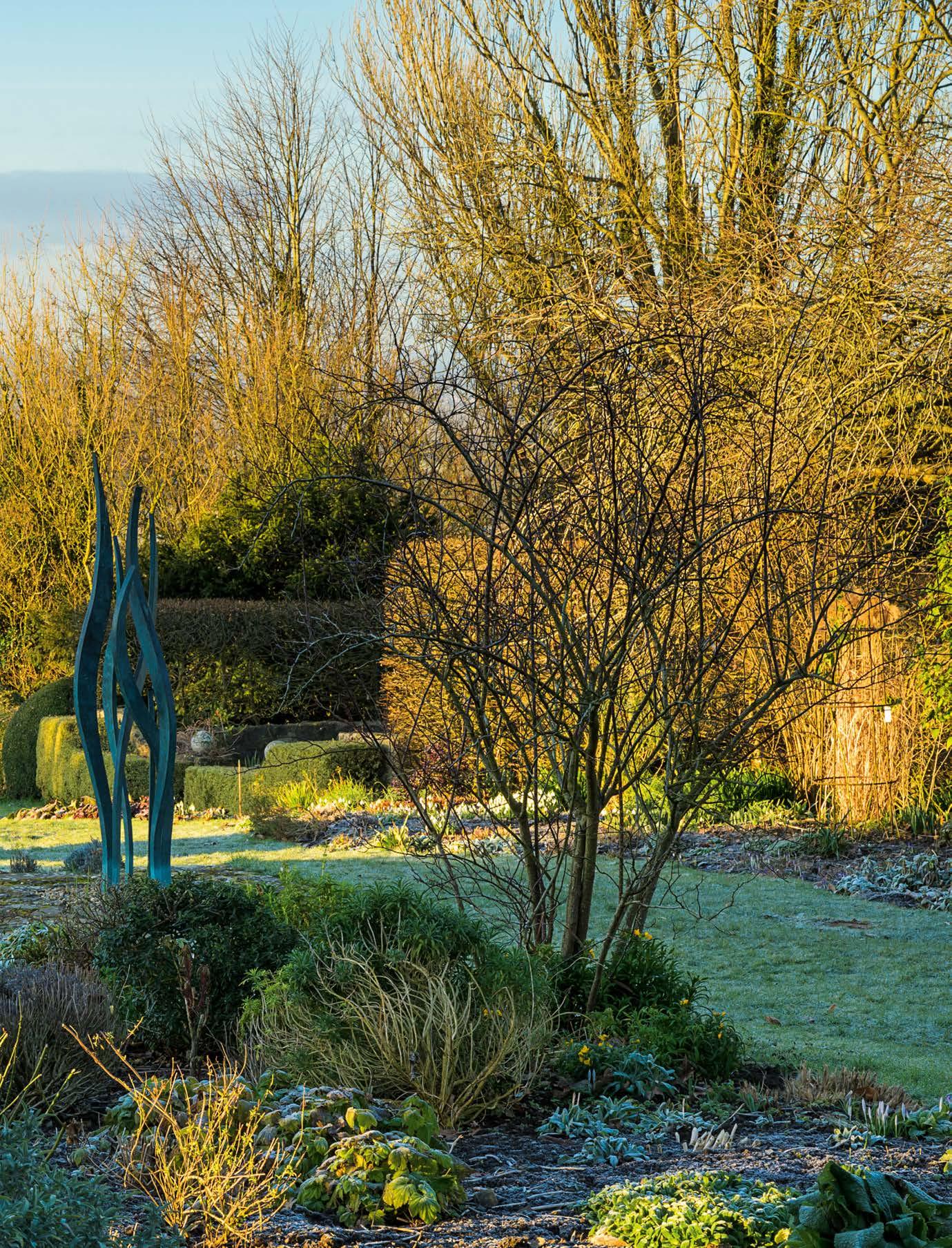




Layers of magnificent bulbs, evergreen structure and specimen flowering trees, provide a dazzling spring display that Anna Vinton has sympathetically developed since her arrival at Stoke Albany House in Northamptonshire 44 years ago




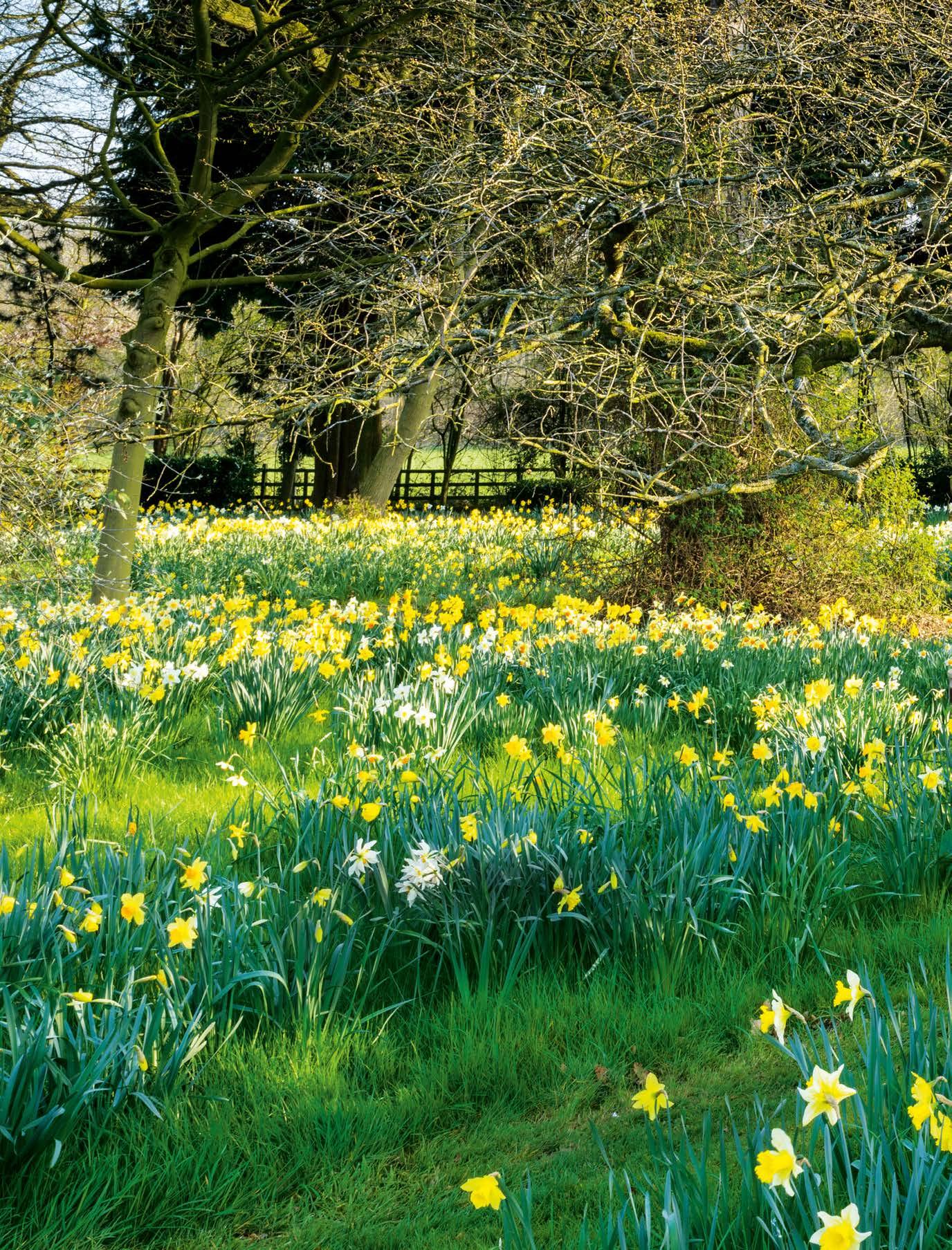 WORDS NICOLA OAKEY PHOTOGRAPHS ANNA OMIOTEK-TOTT
WORDS NICOLA OAKEY PHOTOGRAPHS ANNA OMIOTEK-TOTT
An inviting tree seat is ideally positioned to admire the joyous spring show of thousands of da odils in full flower.

March is the month that most of us consider to be the o cial ‘start’ of spring, but the big question is, will the weather actually be spring-like? The only thing that can be said with any certainty about March is that its weather is unpredictable. Will it come in like a lion and go out like a lamb? That’s anybody’s guess.
To make it even harder to predict what the weather might do, our springs seem to be changing.
According to the Met O ce, March 2022 was the sunniest on record since 1929 and the second sunniest since records began in 1919. It was also pretty mild overall, with above average temperatures for much of the UK – perfect conditions to lure gardeners, already itching to be getting on with things after winter, back outside.
But March gardeners must always be on their guard. Even last March, one of the mildest since the Met O ce started tracking average temperatures in 1884, there were cold snaps at both the start and end of the month. Plants that had burst their buds thanks to the unseasonably clement weather were caught out: foliage was burnt and early flowers were damaged by sharp spring frost.
No one can control the weather, but we can choose what we do and when and how we do it, to minimise weather-related damage and avoid wasted e ort. Key to this is knowing your garden and its soil
Above Cast iron and glass cloches warm the soil below them and can help keep crops sheltered during spring’s unexpected cold snaps.
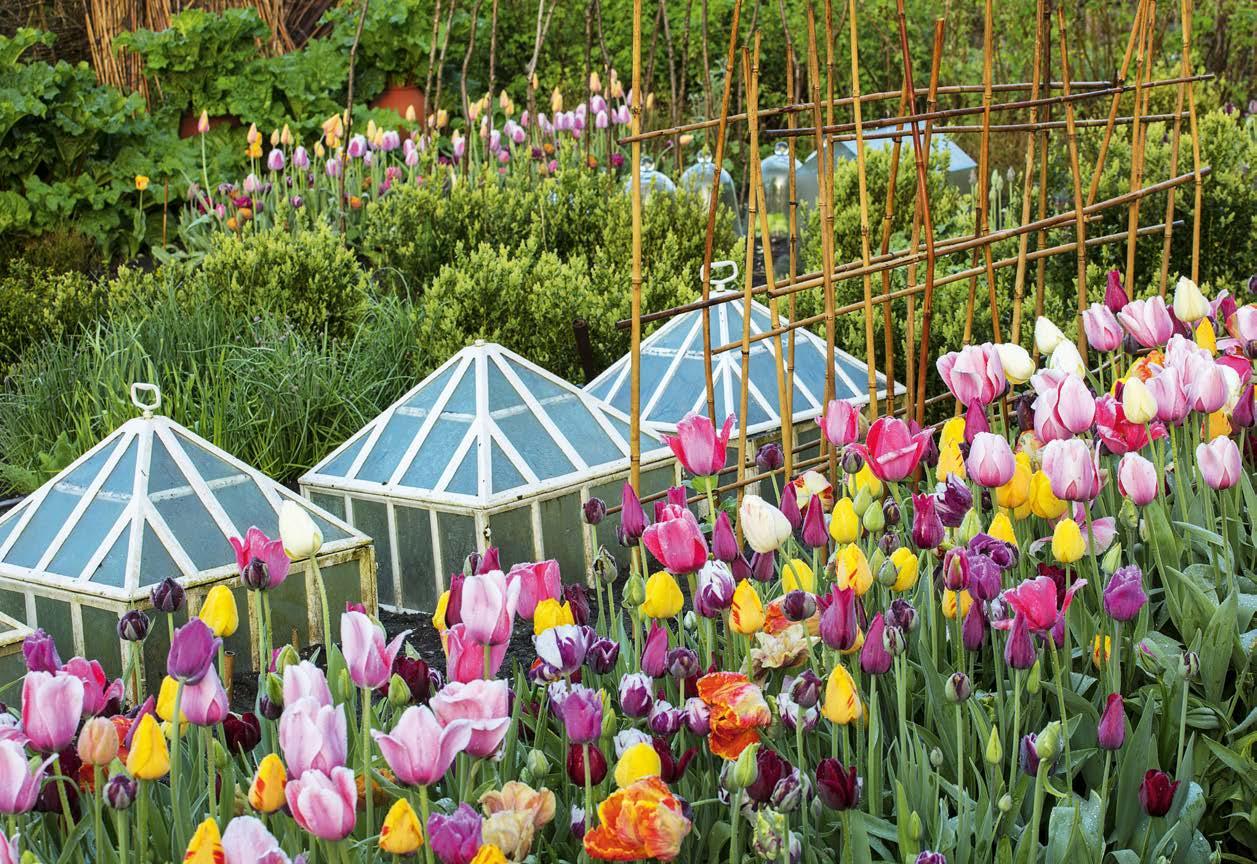
and the plants that can cope with a bit of weather uncertainty. It’s also a good idea to have helpful kit to hand to protect early sowings and help young plants on their way. Here are seven tested ways to get a head start and speed spring up.
There are several ways to tell if the soil is warm enough to start sowing vegetable seeds and the like. Simply feel it and if it’s cold to your touch, it’s unlikely to be conducive to germinating seeds. If weed seedlings are starting to appear, however, it’s a strong sign that conditions will favour your seeds. If temperatures remain stubbornly low and you want to minimise delays, you can help the soil on its way by covering it to warm it up. Lay a clear polythene sheet across the surface of the soil or invest in some mini polytunnels and put them up in the vegetable patch to get a few rows started. Harrod Horticultural (harrodhorticultural.com) and First Tunnels ( firsttunnels.co.uk) have good mini tunnel kits, while Gardening Naturally can supply hoops ( gardening-naturally.com). If the sun shines, things will be toastier within a week or two. The same thinking can also be applied to bagged compost –bring it into the greenhouse a week or two before sowing or planting into it, so it isn’t cold and damp, which will likely be the case if it has been sitting outside at the garden centre.
Left Warming up the soil in a spring vegetable garden by covering sections; a polytunnel also enables an early head start on cropping.


Middle, from left Sow hardy annuals such as sweet peas now; plant early varieties of seed potatoes in March. Bottom Broad beans are always a safe bet for sowing in early spring.
Choose carefully what you sow
There are some plants that can be started o in March regardless of what the weather’s doing: tough customers that don’t mind if the soil’s still chilly. A broad bean seed sown in March will happily sit in the soil and germinate into a sturdy young plant. Alternatively, sow the seeds into pots or modules of compost kept in a coldframe, cool greenhouse or corner of the garden. The advantage of this approach is that when you transplant them into their growing positions there won’t be gaps in the rows; sow direct into open ground and there’s always a chance that a seed or two may not germinate. Shallot or onion sets can be planted, too, either straight into the ground or in modules for transplanting once their roots have filled the cells. Early potato varieties such as ‘Charlotte’ and ‘Anya’ can be planted now as well.

Hardy annuals can also be sown direct now. Do it towards the end of the month or sooner if the soil is warm. Or sow in trays in a cool greenhouse or on a windowsill in the house for pricking out separately and growing on until it’s time to transplant.

A heated propagator transforms seed sowing, delivering the steady, gentle heat that tender vegetables and half-hardy annuals need to germinate. Plug one in on a bright windowsill and crops such as tomatoes can be started o in March alongside some of summer’s brightest flowers. Garland’s ‘Super 7’ electric propagator is designed for windowsills and is widely available online. Try Crocus (crocus.co.uk). The only catch is that once they’ve germinated, these plants will need ongoing warmth to keep on growing. But, by the time they’ve
Above Roots aid soil structure and stop it from washing away.

They host fungi and can add nutrients to soil.
Top right An active compost heap is an essential addition to any new garden.
Right Organic matter is essential for good soil. hügelkultur beds are one way of aiding this.


Below Mulch beds with manure or compost.

into the atmosphere than a large commercial farm, it will still have some e ect.
Just as important is the e ect of digging into what’s known as the rhizosphere. Lying just beneath the soil’s surface, this is the layer where root activity takes place. What happens here directly a ects plant health, but plants also influence the rhizosphere with their own chemicals and root structures. In good soil, the rhizosphere is an intricately connected web of organisms transporting materials to where they are needed and removing those that are unnecessary or even potentially toxic. Disturbing the rhizosphere through regular digging can interrupt this communication and alter the inherent physical structure of the soil, which can become compacted when it is dug or rotovated repeatedly.
What else is in the rhizosphere? Earthworms are one of the most obvious inhabitants and play a vital role in aeration: you won’t find many of them in soil that’s frequently rotovated or lacking organic matter. Fungi and bacteria are also key, even though only a fraction of species have been described to science. Fungi, compellingly written about in Entangled Life by Merlin Sheldrake (The Bodley Head) might turn up overnight as toadstools, but they are also the white strands found often in decomposing wood chip and compost. Sally Morgan, author of The Healthy Vegetable Garden (Chelsea Green) explains that mycorrhizal fungi have a symbiotic relationship with plants, providing the plant with nutrients while receiving sugars in return. Extraordinarily, they also aid communication between plants. It can help to see them as an extension of a plant’s roots, living both in the root and the adjacent soil. Bacteria, of which there are millions and, like fungi, mostly unknown, often rely on fungi to do their work, which includes decomposition.

Meanwhile, a multitude of invertebrates occupies this zone, transporting materials, aerating soil through general activity and eating pests that might a ect our plants. If we find that a shovelful of earth is not actually quietly and benignly crawling with a variety of life forms, it’s a sure sign that something has gone horribly wrong.
One of the best ways to bring life to soil is to add decomposing plant matter to it. “Good soil has good texture. It’s dark and crumbly and it has a lot of organic matter in it,” explains Emma O’Neill, head gardener for Garden Organic at Ryton Organic Gardens in Coventry. Introducing organic matter to her soil is a priority, “whether we dig the beds or not”, she explains. This usually takes the form of a thick mulch applied once but sometimes twice a year. “Usually I do this in autumn, mostly because the timing suits us better, but you can also lay it down in late winter or spring,” she adds.
Often this is compost, “but you can also use decomposing bark chips, cardboard if you remove the tape from it, newspaper and green manures”. Leafmould is valuable and manure, be it stable litter or cow manure, is also worthwhile. Do try to establish that manure sources have not been exposed to the herbicide aminopyralid, which can stunt plant growth. Permaculture practice o ers us hügelkultur: raised no-dig beds rich in organic matter.
Above Earthworms thrive in soil that’s rich in organic matter. They, in turn, aid ecosystems above the surface.
Cerney Gardens is a romantic ‘secret’ garden in 40 acres of Cotswolds parkland with a walled garden. Colour is appearing throughout the garden as the herbaceous borders awaken with an array of snowdrops and hellebores in February and March. In April the walled garden starts to come to life when vibrant tulips appear. Enjoy the peacefulness and tranquillity of nature on the woodland walk and explore the medicinal herb garden. Tea, coffee and homemade cake in the tearoom.
OPEN: Daily from 10am-7pm. £6 per person £1 for children. Dogs on leads welcome. Groups and parties welcome.
Tel: 01638 721416
Wrap up warm and stroll through the extensive gardens and enjoy a selfguided snowdrop walk plus the blossoms of camellia, quince, daphnes, hellebores and early daffodils in grounds of Hever Castle, once the Childhood home of Anne Boleyn.
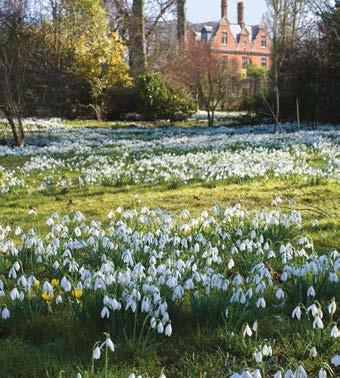

OPEN: From Wednesday 8 February. Please see the website for more details.
The Garden at Kingston Bagpuize House is planted for year-round interest and opens on selected dates from February to September – see website for details. Snowdrop Sundays in February 1-4pm. Explore the garden, parkland and copses surrounding this family home to enjoy the naturalised snowdrops, crocus, aconites and winter flowering shrubs.
DON’T MISS: Sunday 26 February Snowdrop and Spring Plant Fair with ten specialist nurseries 11am-2pm. Also Sunday 28 May Rare Plant Fair www.rareplantfair.co.uk
Forty acres of formal and woodland gardens set around a large lake and ancient canals, boast spectacular displays of snowdrops and aconites in February, followed by a succession of hellebores, scillas, cyclamen, iris, deliciously scented daphnes and viburnums, and a crescendo of daffodils.
RHS Partner Garden since 2020.
OPEN: Tearooms and Gardens open Saturday 21 January to Sunday 2 April 2023.

Come for a Snowdrop Walk around the Hidden Garden of the Cotswolds, awarded the Judges’ Choice of Best Garden of 2022 by the HHA. Children under 12 are free and dogs on leads are welcome.


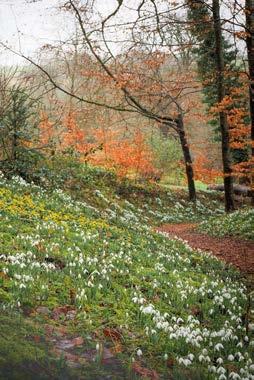
OPEN: Friday 10 February to Friday 3 March from 10am-4pm. £5 per person Our spring and summer opening hours will be 10am-4pm every Wednesday from 1 March until 31 October. Other days by appointment. Entry for 2023 is £15 per person. Tel: 07801 930666
Painshill is a masterpiece of garden design. Designed by Charles Hamilton as a living painting, it is one of the finest 18th century landscape gardens. Walk around a work of art and discover dramatic follies, a serpentine lake, a vineyard and stunning views. With snowdrop, daffodil and bluebell displays, spring is a beautiful time to visit. Complete your day with a visit to the Tea Room. Dogs welcome on short leads.
OPEN: April to October 10am–6pm, November to March 10am–4pm.
Tel: